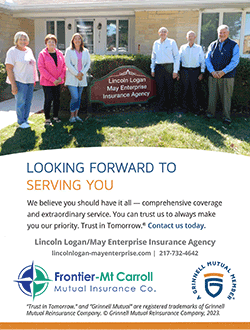As ceasefire takes hold, Hamas returns 3 Israeli hostages and Israel
frees 90 Palestinian prisoners
 Send a link to a friend
Send a link to a friend
 [January 20, 2025]
By WAFAA SHURAFA, SAMY MAGDY, MELANIE LIDMAN and SAM
MEDNICK [January 20, 2025]
By WAFAA SHURAFA, SAMY MAGDY, MELANIE LIDMAN and SAM
MEDNICK
RAMALLAH, West Bank (AP) — After 15 months of collective grief and
anxiety, three Israeli hostages left Hamas captivity and returned to
Israel, and dozens of Palestinian prisoners walked free from Israeli
jail, leaving both Israelis and Palestinians torn between celebration
and trepidation as the ceasefire between Israel and Hamas took hold
Sunday.
The skies above Gaza and Israel were silent for the first time in over a
year, and Palestinians began returning to what was left of the homes
they fled across the war-ravaged enclave, started to check on relatives
left behind and, in many cases, to bury their dead. After months of
tight Israeli restrictions, more than 600 trucks carrying humanitarian
aid rolled into the devastated territory.
The ceasefire that went into effect Sunday morning stirred modest hopes
for ending the Israel-Hamas war.
But in Israel, the joy of seeing freed hostages Emily Damari, Romi Gonen,
and Doron Steinbrecher reunited with their families was tempered by
major questions over the fate of the nearly 100 others abducted in
Hamas’ Oct. 7, 2023, attack, still in captivity in Gaza.
Damari, Gonen and Steinbrecher were the first among 33 Israeli hostages
who are meant to be released in the coming six weeks in a deal that
includes a pause in fighting, the release of nearly 2,000 Palestinian
prisoners and increased fuel and aid deliveries for Gaza.
What happens after the deal's first phase of 42 days is uncertain. The
agreement's subsequent stages call for more releases of hostages and
prisoners and a permanent end to the war.

But Israeli Prime Minister Benjamin Netanyahu, who was pressured by the
outgoing Biden administration and incoming Trump administration to
secure a deal before the president-elect's inauguration Monday in
Washington, has said he received assurances from Trump that Israel could
continue fighting Hamas if necessary.
On Sunday, many Israelis stayed glued to TV screens all afternoon to
glimpse the women being released through the windows of the Red Cross
ambulance. Footage showed them thronged by thousands of jostling
Palestinians, including Hamas gunmen wearing green headbands, as
militants handed them over to the Red Cross on a packed street in Gaza
City.
“An entire nation embraces you,” Netanyahu said.
National Security Minister Itamar Ben-Gvir, a far-right lawmaker who
resigned on Sunday from Netanyahu's governing coalition over the
ceasefire, said the nation was “happy and excited” for their release.
In videos released by the Israeli government, the women were seen
weeping and hugging their family members. Damari raised her bandaged
hand in triumph.
The military said she lost two fingers in the Hamas-led militant attack
on Oct. 7, 2023, that killed over 1,200 people, mostly civilians, and
resulted in the abduction of some 250 others.
Applause erupted among the thousands who gathered to watch the poignant
scenes on large screens at Hostages Square, the Tel Aviv plaza where
families and supporters of hostages have been protesting weekly to
demand a ceasefire deal.
It took another seven hours for such scenes to unfold in the occupied
West Bank, where the mood was initially subdued as the Israeli military
warned that public celebrations for the released prisoners would be
punished.
But scuffles with Israeli security forces and hours of waiting did
little to deter the crowds that flooded the streets around 1 a.m., as
large white buses carrying 90 Palestinian detainees — all women or teens
— exited the gates of Ofer prison, near the West Bank city of Ramallah.
Drivers revved their engines in celebration. Fireworks erupted. Several
men climbed on top of the bus and hoisted three Hamas flags. “God is
greater!” the crowds shouted.

Many of those released expressed elation tinged with grief for the
devastation wrought by the war in Gaza.
A “double feeling” is how the most prominent detainee freed, Khalida
Jarrar, 62, described it. Jarrar is a leading member of the Popular
Front for the Liberation of Palestine, a secular leftist faction that
was involved in attacks against Israel in the 1970s but later scaled
back militant activities. Since her arrest in late 2023, she was held
under indefinitely renewable administrative detention — a widely
criticized practice that Israel uses against Palestinians.
[to top of second column]
|

A bus carrying released Palestinian prisoners arrives to the West
Bank city of Beitunia, early Monday Jan. 20, 2025. (AP Photo/Leo
Correa)

“There’s this double feeling we’re living in, on the one hand, this
feeling of freedom, that we thank everyone for, and on the other
hand, this pain, of losing so many Palestinian martyrs,” she told
The Associated Press.
All of those being released had been detained for what Israel called
offenses related to its security, from throwing stones and promoting
violence on social media to more serious accusations such as
attempted murder.
The next release of hostages and prisoners is due Saturday. In just
over two weeks, talks are to begin on the far more challenging
second phase of the ceasefire agreement.
‘Joy mixed with pain’
In Gaza, there was palpable relief at the prospect of six weeks
without fighting and Israeli bombardment that so far has killed over
46,000 Palestinians, according to Gaza’s Health Ministry, which says
women and children make up more than half the fatalities but does
not distinguish between civilians and fighters.
The skies above the besieged territory were free of Israeli
warplanes for the first day since a weeklong ceasefire in November
2023 that freed over 100 hostages, offering Palestinians a chance to
take stock of the devastation.
“This ceasefire was a joy mixed with pain,” said Rami Nofal, a
displaced man from Gaza City, explaining that his son was killed in
an Israeli airstrike.
Triumphant Hamas militants appeared at some celebrations, as crowds
chanted slogans in support of them. The Hamas-run police reemerged
from months of hiding.
Some families set off for home on foot, their belongings loaded on
donkey carts.
In the southern city of Rafah, residents returned to find massive
destruction that they described as a dystopia. Some found human
remains in the rubble.
“It’s like what you see in a Hollywood horror movie,” Mohamed Abu
Taha said as he inspected the ruins of his family’s home.
Israelis divided over deal
In Israel, the scenes of Hamas gunmen celebrating openly in the
streets of Gaza underscored divisions over the ceasefire deal.
Asher Pizem, 35, from the city of Sderot, said the deal had merely
postponed Israel's next confrontation with Hamas. He also criticized
Israel for allowing aid into Gaza, saying it would contribute to the
militant group’s revival.

“They will take the time and attack again,” he said, looking out
over Gaza’s smoldering ruins from a small hill in southern Israel
with other Israelis gathered to watch as the agreement went into
effect. Warplanes roared, helicopters thudded and drones buzzed in
the final moments before the ceasefire.
An immense toll
The toll of the war has been staggering, and new details about its
scale and impact will emerge.
Israeli forces were pulling back from some areas of Gaza, in line
with the ceasefire agreement, residents of northern Gaza reported.
Some 90% of Gaza’s population has been displaced. Rebuilding — if
the ceasefire leads to the war's end — will take several years at
least.
There should be a surge of humanitarian aid, with hundreds of trucks
entering Gaza daily, far more than Israel allowed before.
“This is a moment of tremendous hope,” U.N. humanitarian chief Tom
Fletcher said. “Fragile, yet vital.”
___
Magdy reported from Cairo, Shurafa from Deir al-Balah, Gaza Strip,
Lidman from Narariya, Israel. Associated Press reporters Josef
Federman in Jerusalem and Mohammad Jahjouh in Khan Younis, Gaza
Strip, contributed to this report.
All contents © copyright 2025 Associated Press. All rights reserved |